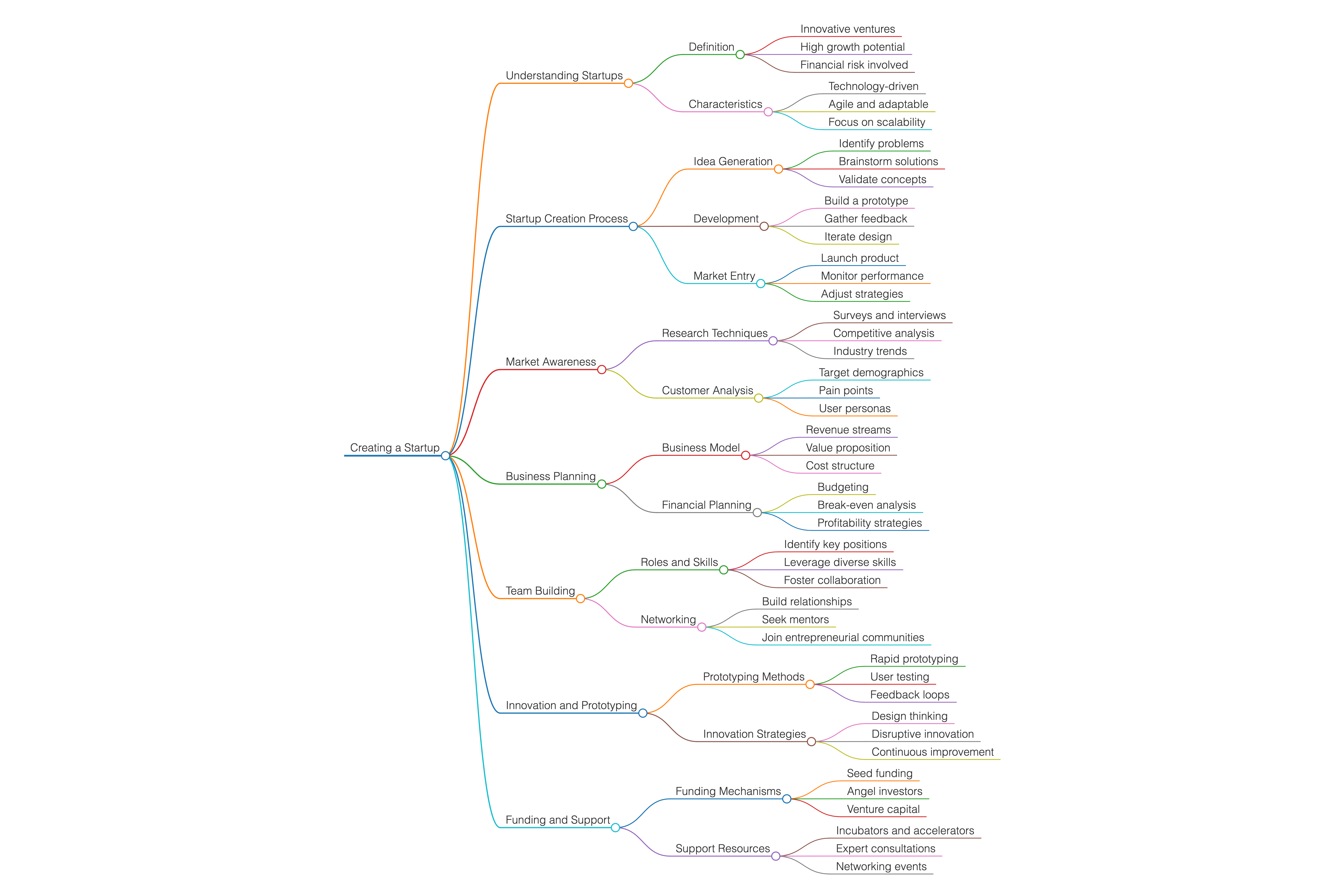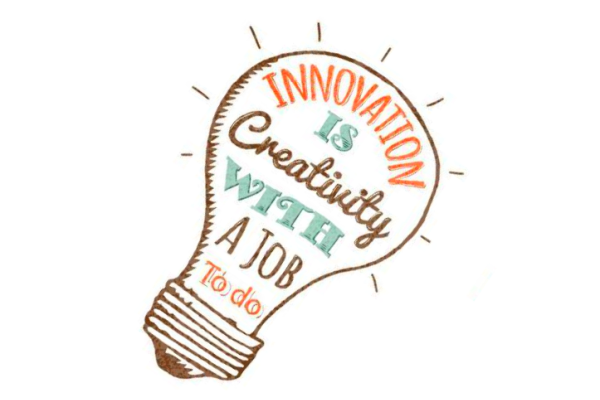Créer et développer une Startup
Aperçu des sections
-
Généralités

-
A Brief Description:
This course provides a concise guide on how to create and grow a startup. It outlines the key characteristics of a startup—such as high growth potential, use of new technology, and operation in uncertain markets—and describes the main stages involved in launching a successful startup. These stages include identifying an innovative idea, conducting market research, developing a business model, building the right team, finding support and funding, prototyping, and finally launching the product or service.
Target Audience of the Course:
Bachelor’s Students in fields such as business, management, computer science, engineering, and economics who are interested in entrepreneurship or starting their own business.Young Entrepreneurs who have an innovative idea and want to understand the process of turning it into a viable startup.
Participants in Incubators or Entrepreneurial Programs who need structured knowledge about startup creation and development.
General Objectives:
Understand the Concept of a Startup
To define what a startup is, its characteristics, and how it differs from traditional businesses.Learn the Key Stages of Building a Startup
To guide learners through the essential steps of creating a startup, from ideation to market launch.Develop Entrepreneurial Thinking
To encourage innovative thinking and the ability to identify or create new market needs.Acquire Practical Tools for Business Development
To provide knowledge on how to conduct market research, build a business model, and secure funding.Promote Collaboration and Networking
To highlight the importance of surrounding oneself with the right team and support network.Understand the Prototyping and Launch Process
To explain how to turn an idea into a tangible product or service and bring it to market.

-
Teacher Contact Details
First and last name : Seladji Yassamine
- Email : yassamine.seladji@univ-tlemcen.dz
-
The course objectives are designed to empower students—especially those at the undergraduate level—with foundational entrepreneurial knowledge and practical tools to launch and grow their own startups.
General Objectives of the Course
Introduce the Concept of a Startup
To help students understand what defines a startup, including its characteristics such as innovation, high growth potential, use of technology, and financial risk.Guide Students Through the Startup Creation Process
To provide a step-by-step framework for launching a startup—from generating an innovative idea to bringing a product to market.Develop Market Awareness and Research Skills
To teach students how to evaluate the relevance of their ideas through effective market research and customer analysis.Build Practical Business Planning Skills
To enable students to create viable business models, define profitability strategies, and calculate key financial indicators.Encourage Team Building and Collaboration
To highlight the importance of surrounding oneself with skilled and trustworthy collaborators in a startup environment.Foster Innovation and Prototyping Competence
To show how to translate ideas into initial versions of products or services through testing and iteration.Equip Students with Knowledge on Startup Funding and Support
To introduce funding mechanisms (design, incubation, launch, and growth) and sources of external support such as experts and incubators.
-
Chapter 1:Generating an Innovative Idea
Sources of innovation: unmet needs, new concepts, intuition, technology-driven solutions
Techniques for idea generation
Evaluating the originality and feasibility of an idea
Chapter 2: Market Research
Purpose and importance of market analysis
Understanding market needs and trends
Validating and refining the idea based on market expectations
Chapter 3: Building the Business Model
Elements of a business model
Defining revenue streams and cost structure
Calculating cost price, profit margin, and rate of return
Chapter 4: Support and Incubation
Role of experts and support organizations
Legal frameworks and startup incubators
Finding mentors and strategic advisors
Chapter 5: Funding Your Startup
Types of funding: design phase, incubation, launch, and growth
Sources of financing (public, private, venture capital, etc.)
Preparing a funding proposal or pitch
Chapter 6: The innovation process
- Innovation through epicenters (resources, supply, customers, finance),
Innovation through strategic questioning,
Innovation through customer experience, and
Innovation using the SWOT method.
Chat: 1 Test: 1 -

This Chapter focuses on the first essential step in setting up a startup: identifying a valuable and innovative idea. It explains that good startup ideas often emerge from identifying problems or unmet needs in the surrounding environment, whether social, technical or economic. It provides techniques for observing and categorising problems, estimating their market relevance, and selecting the most promising idea based on its feasibility and potential impact.
The document also introduces the different types of innovation: ex nihilo, radical and incremental. It encourages creativity by outlining several methods, such as brainstorming, the Crush Process and the Innovation Matrix. These tools help future entrepreneurs to turn ideas into real start-up opportunities.
Page: 1 Fichiers: 2 Forum: 1 Test: 1 Paquetage SCORM: 1 -
This chapter presents the importance of market research in the startup creation process. It explains how market analysis helps validate a business idea, understand customer expectations, define a target audience, and develop a competitive and viable offer.
The document outlines the key steps of conducting market research:
Defining the market and its trends,
Identifying customer segments and analyzing their behaviors,
Studying the demand and the competition (direct and indirect),
Segmenting the market for targeted strategies.
It also includes PESTEL analysis (Political, Economic, Social, Technological, Ecological, Legal) to evaluate the external environment. The final section describes how to synthesize and report findings, identify risks and opportunities, and estimate potential revenue.
Page: 1 Fichier: 1 Forum: 1 Test: 1 -
This chapter introduces the concept of the business model as a fundamental component of a startup's strategy and business plan. It explains how a business model defines what a company sells, how it sells it, and to whom. The document outlines the key steps for building a business model: conducting market research, identifying a target audience, defining strategic positioning, evaluating profitability, and developing a coherent strategy.
The chapter presents the Business Model Canvas as a practical tool for structuring the model across elements such as value proposition, customer segments, channels, customer relationships, revenue streams, key resources, key activities, partners, and cost structure.
It also details several common business model types—including freemium, subscription, direct sales, affiliation, leasing, and low cost—offering real-world examples like Deezer and Netflix. The document emphasizes the flexibility and adaptability of business models in response to evolving market needs and competition.
Page: 1 Fichier: 1 Forum: 1 Test: 1 Paquetage SCORM: 1 -
This chapter focuses on the coaching and support mechanisms available to entrepreneurs during the startup creation process. It explains the importance of being accompanied by professionals, receiving training, and working within collaborative environments to avoid isolation and increase the chances of success. The document describes the roles and benefits of incubators and accelerators, highlighting the services they provide, such as mentorship, funding support, infrastructure, and business development guidance.
It also presents an overview of support structures in Algeria, including national agencies and institutions that assist startups with financial, legal, technical, and intellectual property support. These include the ANDPME, INAPI, chambers of commerce, ANDI, and ANVREDET. Overall, the document emphasizes that strong support systems are essential to help startups move from idea to implementation and scale effectively.
Page: 1 Fichier: 1 Forum: 1 Test: 1 -
This Chapter outlines the key concepts and stages of funding a startup, from its inception through growth. It emphasizes the importance of building a credible team, developing a strong business model, and conducting thorough market research to attract financial partners.
The document describes the four main funding phases:
Incubation phase – support from incubators and public programs.
Seed phase – early funding by business angels.
Starting phase – venture capital investment for growth and structure.
Growth phase – expansion financing for mature startups.
It also explains different types of financing, including:
Own funds (personal savings or in-kind contributions),
Fundraising (seed capital, competitions, state support),
Bank loans (with equity and guarantees),
Financial aid (public and private programs).
Additionally, it highlights funding structures in Algeria, such as ANDPME, INAPI, ANDI, and ANVREDET, which provide legal, technical, financial, and strategic support to startups.
Page: 1 Fichier: 1 Forum: 1 Paquetage SCORM: 1 -
This document explores the strategic role of the business model in a startup’s success, emphasizing its importance as the core of the business plan. It presents the steps involved in building a business model—market analysis, target definition, positioning, profitability evaluation, and strategy design—while focusing on how to integrate innovation throughout this process.
The text introduces several innovation approaches, including:
Innovation through epicenters (resources, supply, customers, finance),
Innovation through strategic questioning,
Innovation through customer experience, and
Innovation using the SWOT method.
The document includes a practical case study (Facebook) to illustrate how SWOT can be used to assess strengths, weaknesses, opportunities, and threats in a real business model context. Overall, the document encourages future entrepreneurs to build dynamic, customer-oriented, and innovative business models that adapt to changing market conditions.
Test: 1 Page: 1 Fichier: 1 Forum: 1 Paquetage SCORM: 1 -
Ries, E. (2011).
The lean startup: How today's entrepreneurs use continuous innovation to create radically successful businesses.
New York: Crown Business.
ISBN: 978-0307887894
Osterwalder, A., & Pigneur, Y. (2010).
Business model generation: A handbook for visionaries, game changers, and challengers.
Hoboken, NJ: John Wiley & Sons.
ISBN: 978-0470876411
Thiel, P., & Masters, B. (2014).
Zero to one: Notes on startups, or how to build the future.
New York: Crown Business.
ISBN: 978-0804139298
Christensen, C. M. (1997).
The innovator’s dilemma: When new technologies cause great firms to fail.
Boston: Harvard Business Review Press.
ISBN: 978-1633691780
Blank, S., & Dorf, B. (2012).
The startup owner’s manual: The step-by-step guide for building a great company.
Pescadero, CA: K & S Ranch Publishing.
ISBN: 978-0984999309
Cremades, A. (2016).
The art of startup fundraising: Pitching investors, negotiating the deal, and everything else entrepreneurs need to know.
Hoboken, NJ: Wiley.
ISBN: 978-1119191834
